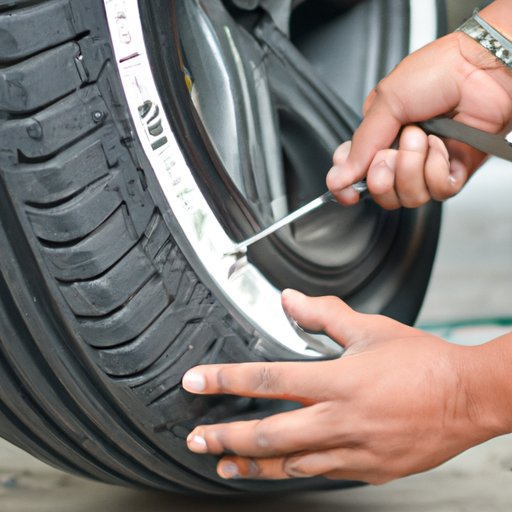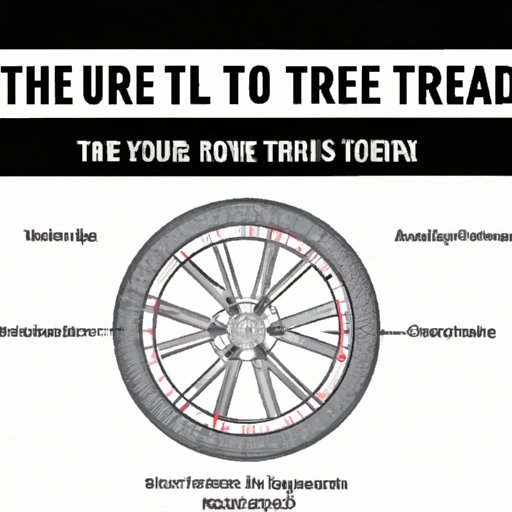
Introduction
Tire maintenance is essential to ensuring safe driving conditions and a smooth ride for your vehicle. Among the most important aspects of tire upkeep is monitoring tire tread depth. Checking your tire tread regularly and ensuring it is at the recommended depth can help prevent accidents and extend the life of your tires. This article outlines seven easy steps to accurate measurements, explores the various methods of checking tire tread depth, and offers tips and tricks for accurate results.
7 Easy Steps to Checking Your Tire Tread Depth
Step 1: Choose a reliable measuring method
There are several methods to measure tire tread depth, but it is essential to choose a reliable method of measurement to ensure accurate results. Using a tread depth gauge, which is available at most auto stores, is the most reliable technique.
Step 2: Find your tire’s tread wear indicator
Most tires have a “tread wear indicator,” which is a bar that runs perpendicular to the tire’s tread patterns. The indicator can be found in the tire’s grooves. If the tire’s tread has worn down to the indicator, it is time to replace the tire.
Step 3: Use a tread depth gauge to measure depth
Press the depth gauge into the tire’s grooves and hold it steady to get an accurate measurement. Be sure to measure in different spots on each tire to get an overall sense of the tires’ tread depth.
Step 4: Repeat measurement in multiple spots on each tire
Measure at least three to four spots spread across each tire to ensure an accurate reading of the tire’s overall condition. This will also help you detect any uneven wear patterns that could indicate other problems.
Step 5: Compare measurements to recommended depth
Consult your vehicle manual or the manufacturer’s website to find the recommended tread depth for your specific tires. Most tires have a recommended depth of 2/32 of an inch. If your measurement is below the recommended depth, it’s time to replace the tire.
Step 6: Determine if your tires need replacing
If your measurement is below the recommended tread depth, it’s time to replace the tire. If only one tire has worn down, it’s best to replace both front or both rear tires at once to prevent uneven wear on the new tire.
Step 7: Get a professional inspection if necessary
If you’re unsure if the tire needs to be replaced, it’s best to take it to a professional. A tire technician can give you a more accurate assessment of the tire’s condition and recommend the appropriate course of action.
The Importance of Checking Your Tire Tread and 5 Ways to Do It
Explanation of why tire tread is important
Tire tread is essential to your vehicle’s stability and traction. Adequate tread depth helps prevent accidents, especially on wet or slippery roads. Tread depth also helps extend the life of the tire by preventing uneven wear patterns.
Method 1: Visual inspection
A quick visual inspection can give you a general idea of your tire’s tread condition. Look for any bald spots, cracks, or uneven wear patterns.
Method 2: The penny test
The penny test is a quick and easy way to check tread depth. Insert a penny into your tire’s grooves with Lincoln’s head upside down and facing you. If you can see all of Lincoln’s head, your tread depth is too low, and it’s time to replace the tire.
Method 3: The quarter test
The quarter test is similar to the penny test but uses a quarter instead. Insert a quarter into the tire’s grooves with the eagle’s head upside down and facing you. If the top of the eagle’s head is visible, you need to replace the tire.
Method 4: Tread depth gauge
The tread depth gauge is the most accurate method of determining tire tread depth. It measures the depth of the tire’s grooves, providing you with an accurate reading of your tire’s tread depth.
Method 5: Wear bars
Wear bars are the indicators on your tire to tell you when it’s time for a replacement. If you see these bars, it’s time to replace your tire.
Quick and Simple Guide to Measuring Your Tire Tread Depth
Overview of the guide
Here’s a quick and simple guide to measuring your tire tread depth:
Explanation of measuring techniques
Explained previously in the steps outlined in this article.
How to use a tread depth gauge
Hold the gauge in the tire’s grooves and press down until it reaches the bottom of the groove. Read the measurement and compare it to the recommended depth.
Benefits of the quick and simple method
This method provides accurate measurements of your tire’s tread depth and is easy and quick to perform.
How to Check Tire Tread: Tips and Tricks for Accurate Results
Explanation of why accurate results are important
Accurate results are essential to knowing the condition of your tires and when it’s time for a replacement.
Tip 1: Measure in different spots on tire
Measuring in different spots on the tire ensures you get an accurate reading of the tire’s overall condition and detects any uneven wear.
Tip 2: Measure all four tires
Measuring all four tires provides you with a comprehensive view of your vehicle’s tire health.
Tip 3: Measure tires at least once a month
Measuring your tires once a month helps ensure that you catch any issues early and can take the appropriate course of action.
Tip 4: Use the same method each time
Using the same method each time ensures consistency and accuracy in your measurements.
Tip 5: Confirm results with a professional inspection
A professional inspection can confirm your results and provide you with additional guidance on the appropriate course of action.
Mastering the Art of Tire Tread Inspection: A Step-by-Step Process
Overview of the process
This process is similar to the seven easy steps outlined earlier, providing a more detailed examination of the tire tread inspection process.
Detailed explanations of each step
Detailed explanations provided earlier.
DIY Guide to Checking Your Tire Tread Depth: What You Need to Know
What is a DIY guide?
A DIY guide is a step-by-step breakdown of how to perform a task on your own without professional help.
Explanation of why DIY is helpful
A DIY guide can save you time and money by allowing you to perform simple tasks on your own without incurring additional costs.
Materials needed for DIY inspection
A tread depth gauge and a small ruler
Step-by-step guide to measuring tread depth
Simple guide provided in earlier sections.

The Complete Guide to Evaluating Your Tire Tread: From Basics to Advanced Techniques
Explanation of advanced techniques
Advanced techniques offer a more in-depth assessment of tire tread health and require specialized tools.
Technique 1: Using a digital tread depth gauge
A digital tread depth gauge provides more precise measurements than a regular tread depth gauge.
Technique 2: The wet road test
The wet road test involves driving on a wet surface to determine your tire’s traction ability.
Technique 3: The coin-edge test
The coin-edge test involves using the edge of a coin to measure tread depth.
Explanation of when to use advanced techniques
Advanced techniques should be utilized when you require a more in-depth assessment of the tire’s condition and have the appropriate tools.
Conclusion
Recap of article
Regular tire tread checks are essential to maintaining a safe vehicle. Accurate measurements of tire tread depth provide insight into a tire’s health and can help prevent accidents and extend its lifespan. This article provided a comprehensive guide to checking tire tread depth, including seven easy steps, various measurement methods, and tips and tricks for accurate results.
Final thoughts
Regular tire maintenance is essential to ensuring safe driving conditions and maximizing your vehicle’s lifespan. Make sure to check your tire tread regularly and take the appropriate course of action if necessary.
Call to action for readers to check their tire tread
Don’t wait until it’s too late, take a moment to check your tire tread today. Regular maintenance is a small step that can go a long way in ensuring your safety on the road.




